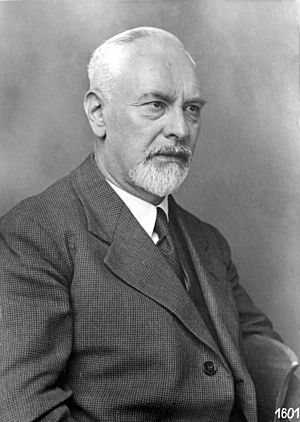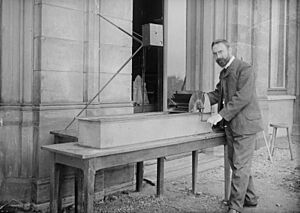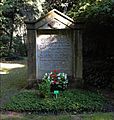Ludwig Prandtl facts for kids
Quick facts for kids
Ludwig Prandtl
|
|
|---|---|

Ludwig Prandtl
|
|
| Born | 4 February 1875 Freising, Upper Bavaria, German Empire
|
| Died | 15 August 1953 (aged 78) |
| Nationality | German |
| Alma mater | Technical University of Munich, RWTH Aachen |
| Known for | Boundary layer Mixing length theory Lifting-line theory Membrane analogy Prandtl box wing Prandtl condition Prandtl number Prandtl stress function Prandtl tube Prandtl's one-seventh-power law Prandtl–Meyer expansion fan Prandtl–Meyer function Prandtl–Batchelor theorem Prandtl–Glauert transformation Prandtl–Glauert singularity Prandtl–Tomlinson model Kármán–Prandtl resistance equation |
| Awards | Ackermann–Teubner Memorial Award (1918) ForMemRS (1928) Daniel Guggenheim Medal (1930) Harnack Medal (1936) Wilhelm Exner Medal (1951) |
| Scientific career | |
| Fields | Aerodynamics |
| Institutions | University of Göttingen, Technical University of Hannover |
| Thesis | Tilting Phenomena, A case of unstable elastic balance (1899) |
| Doctoral advisor | August Föppl |
| Doctoral students | Ackeret, Blasius, Busemann, Munk, Nikuradse, Schlichting, Tollmien, von Kármán, Timoshenko, Vâlcovici, Vishnu Madav Ghatage |
Ludwig Prandtl (born February 4, 1875 – died August 15, 1953) was a German scientist. He studied how liquids and gases move, which is called fluid dynamics. He was also a physicist and an aerospace scientist. Prandtl was a pioneer in using math to understand aerodynamics. This is the science of how air moves around objects, especially planes. His work became the foundation for aeronautical engineering, which is about designing and building aircraft.
In the 1920s, he developed key mathematical ideas for how air flows at speeds below and even near the speed of sound. He identified important concepts like the boundary layer, thin airfoils (wing shapes), and lifting-line theory. The Prandtl number, a value used in physics, is named after him.
Contents
Early Life and Discoveries
Prandtl was born in Freising, a town near Munich, on February 4, 1875. His mother was sick for a long time. Because of this, Ludwig spent more time with his father, who was an engineering professor. His father encouraged him to look closely at nature and think about what he saw.
In 1894, Prandtl started studying at the Technische Hochschule Munich. He earned his Ph.D. in six years, guided by Professor August Foeppl. His main project was about how things can tilt and become unstable.
After university, Prandtl worked at a company called Maschinenfabrick Augsburg-Nürnberg. He was trying to make a device better that sucked up wood shavings. He noticed that the suction tube didn't work well. This was because the air flow separated from the tube's walls. This meant the pressure didn't increase as expected. This problem had been seen before by Daniel Bernoulli with water. Prandtl realized this problem helped him understand how fluids with a little bit of stickiness (viscosity) create resistance. This idea led to his famous boundary layer theory.
Later Career and Key Theories
In 1901, Prandtl became a professor of fluid mechanics at a technical school in Hannover. This school later became the University of Hannover. It was here that he developed many of his most important ideas. On August 8, 1904, he gave a very important presentation. It was called On the Motion of Fluids in Very Little Friction. He gave it at a big math meeting in Heidelberg.
Understanding Airflow: The Boundary Layer
In his presentation, Prandtl explained the boundary layer. This is a very thin layer of air right next to an object, like an airplane wing. He showed how important this layer is for drag (the force that slows an object down) and for making objects streamlined (smooth shapes that move easily through air).
His paper also explained flow separation. This happens when the boundary layer separates from the surface. This separation clearly explained for the first time why planes can stall. A stall happens when a wing loses its ability to create lift. Many of his students tried to find perfect mathematical solutions, but they couldn't. So, Prandtl's original idea is still widely used today.
The impact of his paper was huge. Later that year, Prandtl became the director of the Institute for Technical Physics at the University of Göttingen. Over the next few decades, he turned it into a world-leading center for aerodynamics. In 1925, the university created a separate research center for his work. It was called the Kaiser Wilhelm Institute for Flow Research. Today, it's known as the Max Planck Institute for Dynamics and Self-Organization.
Designing Better Wings
Following earlier work by Frederick Lanchester, Prandtl worked with Albert Betz and Max Munk. They wanted to create a useful math tool to study how "real world" wings create lift. Their findings were published between 1918 and 1919. This became known as the Lanchester–Prandtl wing theory.
Prandtl also added specific ideas to study curved airfoils, like those on World War I aircraft. He published a simpler thin-airfoil theory for these designs. This work showed that on any wing that isn't infinitely long, the effects at the wing tips are very important. He did a lot of work on induced drag and wingtip vortices. These are swirling air currents that form at the ends of wings. Before Prandtl, these were often ignored.
Prandtl showed that if a wing's lift is spread out in an elliptical (oval) shape along its length, it creates the least amount of induced drag. These tools allowed aircraft designers to study their planes using math before they were even built.
Prandtl later expanded his theory. He described a way to make the wing tips create negative lift. This would give the least induced drag for any given aircraft weight. He also suggested that forces that make a plane yaw (turn sideways) could be controlled just by the wing tips. This new idea was mostly overlooked. However, in the 21st century, an American engineer named Al Bowers confirmed this idea. He called his experimental wing the Prandtl-D.
Supersonic Flight and Shock Waves
In 1908, Prandtl and his student Theodor Meyer developed the first ideas about supersonic shock waves and air flow. These are waves created when an object moves faster than sound. The Prandtl–Meyer expansion fans they discovered allowed scientists to build supersonic wind tunnels. These tunnels are used to test models at very high speeds.
Prandtl didn't have much time to work on this problem again until the 1920s. Then, he worked with Adolf Busemann. In 1929, they created a method for designing special nozzles for supersonic flow. Today, all supersonic wind tunnels and rocket nozzles use this same design method. The full development of supersonic ideas was later continued by Theodore von Kármán, who was one of Prandtl's students.
Other Contributions
In 1922, Prandtl helped found the GAMM. This is an international group for applied math and mechanics. He was its chairman from 1922 to 1933. Until 1945, he also worked closely with the German air ministry.
Prandtl also studied how air behaves at high speeds when it starts to compress. This is known as the Prandtl–Glauert correction. This was very useful during World War II when aircraft began to fly close to supersonic speeds. He also worked on meteorology (the study of weather), how materials deform (plasticity), and how structures are built (structural mechanics). He also made important contributions to tribology, which is the study of friction, wear, and lubrication.
Prandtl and the Nazi Era
After Adolf Hitler came to power and the Third Reich was established, Prandtl continued to lead the Kaiser Wilhelm Society. During this time, the Nazi air ministry, led by Hermann Göring, often used Prandtl's international fame as a scientist. They used it to promote Germany's scientific goals. Prandtl seemed to be happy to represent the Nazi government. In 1937, he wrote to a representative from NACA (an American aviation group). He said he believed that Fascism in Italy and National Socialism in Germany were "very good beginnings of new thinking and economics."
As a member of the German Physical Society (DPG), Prandtl helped Carl Ramsauer write a petition in 1941. This petition was published in 1942. It argued that physics in Germany was falling behind the United States. This was because German physicists were rejecting "Jewish Physics," which included relativity and quantum theory. After this petition, the idea of "German Physics" being superior changed. This allowed German students to study these new fields in school.
Legacy and Recognition
Prandtl continued his work in Göttingen until he passed away on August 15, 1953. His work in fluid dynamics is still used today in many areas of aerodynamics and chemical engineering. He is often called the "father of modern aerodynamics."
The crater Prandtl on the far side of the Moon is named in his honor.
The Ludwig-Prandtl-Ring is an award given by the Deutsche Gesellschaft für Luft- und Raumfahrt (German Society for Aeronautics and Astronautics). It honors outstanding contributions in aerospace engineering.
In 1992, Prandtl was added to the International Air & Space Hall of Fame at the San Diego Air & Space Museum.
Images for kids
See also
 In Spanish: Ludwig Prandtl para niños
In Spanish: Ludwig Prandtl para niños
- Tesla turbine
- Particle image velocimetry
- Wind tunnel
- Subsonic and transonic wind tunnel
- Pitot tube
- Prandtl's one-seventh-power law
- Prandtl-M NASA research aircraft Preliminary Research Aerodynamic Design to Land on Mars, a backronym honoring Prandtl



